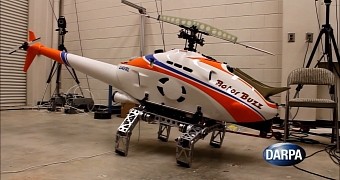At the moment, Pentagon's sharpest minds gathered in US' most advanced technology development office, DARPA, are working on a way to solve one of the greatest limitations of helicopters: landing on uneven surfaces, or even worse, moving terrain.
Landing on moving ships that tilt left and right because of waves, or on angled surfaces and rough terrains, in order to save lives or simply transport people has been a major issue for helicopters, which represent the vast majority of vehicles used by emergency crews across the world. Today, level surfaces are the best place to put a helicopter down, and only extremely experienced pilots manage to land helicopters on the most dangerous and even moving surfaces.
However, this sort of feat requires some high levels of coordination between man and machine, and bold attempts not rarely end up in disaster. In order to allow less experienced pilots to land their choppers on less than perfect places, the Robotic Landing Gear is being developed by DARPA, and it is currently flown in miniature RC models, with plans to be implemented in real-life helicopters in the near future.
Replace skids and wheels with mechanical legs
The idea behind the Robotic Landing Gear is fairly simple: the standard helicopter skids, or fixed wheel landing gear, are to be replaced by an adaptive system via the use of automatically articulating landing legs. These legs will fold tight, or even inside the helicopter fuselage, while cruising, and when the machine is preparing to land, they will stretch out and touch down by "feeling" the ground, similar to how four-legged animals find balance on uneven terrain.
Some force sensors that are tied to a central computer will determine the right angle for each leg, so the helicopter will always remain stable on any sort of terrain. Apparently, the legs manage to land helicopters on slopes of up to 20 degrees, and most importantly, the gear is meant for the army as well. Moreover, it can help choppers land on pitching and rolling ship decks without a problem.
Right now, DARPA and their partner, Georgia Institute of Technology, are continuing their RC helicopter tests, with a manned full-scale machine probably following soon.

 14 DAY TRIAL //
14 DAY TRIAL // 